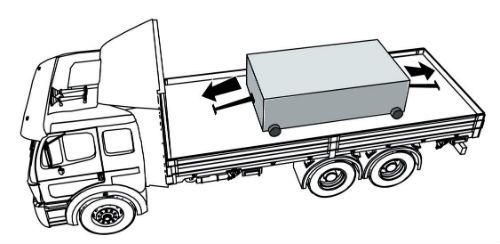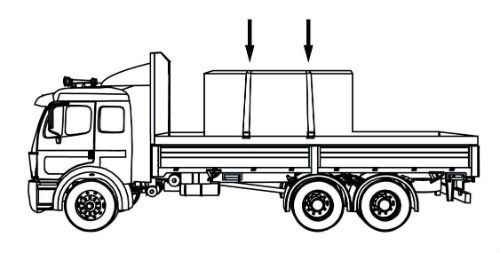CDL Practice Tests: Flatbed Cargo Securement
Choose A Section:
Go!What is the minimum nominal dimension of timber blocking used to secure concrete pipe?
- 8 x 10 in
- 4 x 6 in
- Half the diameter of the pipe
- 2 x 4 in
Blocking must be:
- Placed against the pipe
- Secured to prevent it from moving out from under the pipe.
Timber blocking must have a minimum nominal dimension of 10 x 15 cm (4 x 6 in).
How many tiedowns are required on a stack of shortwood loaded crosswise?
- 3
- 1
- It depends on the weight
- 2
Tiedowns requirements

Use two tiedowns to secure one stack of shortwood loaded crosswise.
Attach the tiedowns to the vehicle frame at the front and rear of the load.
Position tiedowns approximately 1/3 and 2/3 of the length of the logs.
All of the following are requirements for transporting coils with eyes crosswise except:
- Prevent the coil from rolling
- These are all requirements
- Attach one tiedown forward
- Attach one tiedown rearward
There are three requirements for coils transported with eyes crosswise:

Prevent the coil from rolling
Attach one tiedown forward.
Attach one tiedown rearward.
If loading and securing paper rolls on a second layer:
- Be sure the bottom layer extends to the front of the vehicle.
- Lay the second layer horizontally.
- Stack the second layer at the back.
- Make sure heavier rolls are on top.
Stacked Loads
- Load paper rolls on a second layer only if the bottom layer extends to the front of the vehicle.
-
Prevent forward, rearward, or side-to-side movement:
- Either by the same means required for the bottom layer
- Or by the use of a blocking roll from a lower layer.
- A roll in the rearmost row of any layer must not be raised using dunnage.
When securing rows of coils, requirements include all of the following except:
- Attach at least one tiedown through the center of each row of coils.
- Attach at least one tiedown over the top of each coil or side-by-side row, located near the front of the coil.
- Use blocking or friction mats to prevent forward movement.
- Attach at least one tiedown over the top of each coil or side-by-side row, located near the rear of the coil.
Tiedowns

Attach at least one tiedown over the top of each coil or side-by-side row, located near the front of the coil.
Attach at least one tiedown over the top of each coil or side-by-side row, located near the rear of the coil.
Use blocking or friction mats to prevent forward movement.
Which of the following is not true of Working Load Limit (WLL)?
- The Working Load Limit is the maximum load that may be applied to a component of a cargo securement system.
- All of these are true.
- The minimum WLL requirement for the securement system is 25%.
- The WLL is usually assigned by the component manufacturer.
The Working Load Limit is the maximum load that may be applied to a component of a cargo securement system during normal service.
The WLL is usually assigned by the component manufacturer.
Note: The minimum WLL requirement for the securement system is 50%. More tiedown capacity should be used if you need to secure an article against any movement.
Within the requirements for concrete pipe, which of these requires specific securement methods?
- Concrete pipe loaded cross-wise on a flatbed trailer.
- Concrete pipe eyes vertical and concrete pipe loaded lengthwise.
- Concrete pipe loaded in a sided vehicle or container.
- Concrete pipe that is grouped together into a single rigid article and may not roll.
What is exempt from these specific requirements?
Follow general cargo securement requirements (Section 2) when transporting the following pipe:
- Concrete pipe that is grouped together into a single rigid article and may not roll.
- Concrete pipe loaded in a sided vehicle or container.
- Concrete pipe eyes vertical and concrete pipe loaded lengthwise.
What is covered under these specific requirements?
Any concrete pipe loaded crosswise on a platform trailer or vehicle that is not exempt.
A hook-lift container is:
- A specialized container, primarily used to contain and transport materials in the waste, recycling, construction/demolition, and scrap industries, which are used in conjunction with specialized vehicles, in which the container isloaded and unloaded onto a tilt frame body by an articulating hook-arm.
- A vehicle especially built and fitted with locking devices for the transport of intermodal containers.
- A reusable, transportable enclosure that is especially designed with integral locking devices that secure it to a container chassis trailer to facilitate the efficient and bulk shipping and transfer of goods by, or between various modes of transport, such as highway, rail, sea, and air.
- The load carrying area of a truck, trailer, or intermodal container.
Hook-lift Container:
A specialized container, primarily used to contain and transport materials in the waste, recycling, construction/demolition, and scrap industries, which are used in conjunction with specialized vehicles, in which the container isloaded and unloaded onto a tilt frame body by an articulating hook-arm.
In what circumstance can shortwood be treated as longwood?
- When it is stacked long-ways on the trailer.
- Right after it is cut down.
- When it is embedded in a stack of longwood.
- When it is painted green on the ends.
What's in a stack?

Some stacks may be made up of both shortwood and longwood. Any stack that includes shortwood must follow the shortwood securement requirements.
Exception: If shortwood is embedded in load of longwood, it can be treated as longwood.
Methods to keep a cradle from sliding include:
- Friction mats under the cradle.
- Nailed wood blocking or cleats.
- Placing a tiedown around the front of the cradle.
- These can all be used.
Requirements for securing a single coil
Prevent the coil from rolling by supporting it:
- Timbers, chocks, or wedges held in place by coil bunks or similar devices to prevent them from coming loose.
- A cradle (for example, two hardwood timbers and two coil bunks) that is restrained from sliding by:
- Friction mats under the cradle.
- Nailed wood blocking or cleats.
- Placing a tiedown around the front of the cradle.
- The support must:
- Support the coil just above the deck.
- Not become unintentionally unfastened or loose in transit.
About The Flatbed Cargo Securement CDL Manual
Studying the flatbed cargo securement CDL manual is not a requirement for getting your CDL permit or license. It is required knowledge for flatbed drivers.
Some questions you should be able to answer for flatbed cargo securement:
- What is the minimum Working Load Limit of a tiedown used to secure logs?
- What is the minimum weight of a shipment of paper rolls that would require specific securement requirements?
- When securing concrete pipe over 45 inches loaded crosswise, which direction must the tiedowns on the front half of the load run?
- What is a cab shield?
- When securing concrete pipe over 45 inches loaded crosswise, which direction must the tiedowns on the rear half of the load run?
- What is a dunnage bag?
- Who is responsible for inspecting securing devices and cargo within the first 50 miles?
- How many tiedowns are required on a stack of shortwood loaded crosswise?
- What is the minimum working load limit of each tiedown used to secure crushed or flattened vehicles?
- Define 'bolster'
- What is a hook-lift container?
- When a tiedown is attached directly to the cargo, what is the ideal angle where it attached to the vehicle?
What is a securing device?
Any device specifically manufactured to attach or secure cargo to a vehicle or trailer:
- Synthetic Webbing
- Chain
- Wire rope
- Manila rope
- Synthetic rope
- Steel strapping
- Clamps and latches
- Blocking
- Front-end structure
- Grab hooks
- Binders
- Shackles
- Winches
- Stake pockets
- D-rings
- Webbing ratchet
- Bracing
- Friction mat
What is a tiedown?
A combination of securing devices that forms an assembly that:
- Attaches cargo to, or restrains cargo on a vehicle.
- Is attached to anchor point(s).

Some tiedowns are attached to the cargo and provide direct resistance to restrain the cargo from movement.

Some tie-downs pass over or through the cargo. They create a downward force that increases the effect of friction between the cargo and the deck. This friction restrains the cargo.
 Related Cargo Securement Terms That Every Driver Should Know:
Related Cargo Securement Terms That Every Driver Should Know:
-
Tiedown:
A combination of securing devices which form an assembly that attaches cargo to, or restrains cargo on, a vehicle or trailer, and is attached to anchor point(s).
-
Contained:
Cargo is contained if it fills a sided vehicle, and every article is in contact with or sufficiently close to a wall or other articles so that it cannot shift or tip if those other articles are also unable to shift or tip.
-
Blocking:
A structure, device, or another substantial article placed against or around an article to prevent horizontal movement of the article.
How should tiedowns be attached?
Tiedowns can be used in two ways:
-
Attached to the cargo:
- Tiedowns attached to the vehicle and attached to the cargo.
- Tiedowns attached to the vehicle, pass through or aroundan article of cargo, and then are attached to the vehicle again.
-
Pass over the cargo:
- Tiedowns attached to the vehicle, passed over the cargo, and then attached to the vehicle again.
Tiedown placement:

Place the tiedown as close as possible to the spacer.
Position the tiedowns as symetrically as possible over the length of the article.

Position the tiedowns to preserve the integrity of the article.







 TT On Facebook
TT On Facebook